UPDATE: TUESDAY, 11 a.m.—Nearly one month after Hurricane Matthew made landfall in Haiti, Heifer continues efforts to provide aid to families and communities affected by the storm.
In addition to the food kits and meals already distributed throughout the island, Heifer Haiti is set to pass out more than 300 metric tons of food in coordination with the World Food Program, said Hervil Cherubin, country director. Tuesday was the first large public distribution—more than 100 tons when to 1,500 families. The remainder will be distributed Thursday, Saturday and next Monday, he said.
The aid was complicated last week by more storms, which flooded Les Cayes and Baie de Henne. "That situation led to more damage to our communities," Cherubin said. "More livestock were lost and the water system we built was damaged."
Despite the complications, the team continues to care for livestock with mobile veterinary clinics. As of October 27, the team had cared for nearly 23,000 animals and is continuing the clinics to ensure the animals' health.
-----
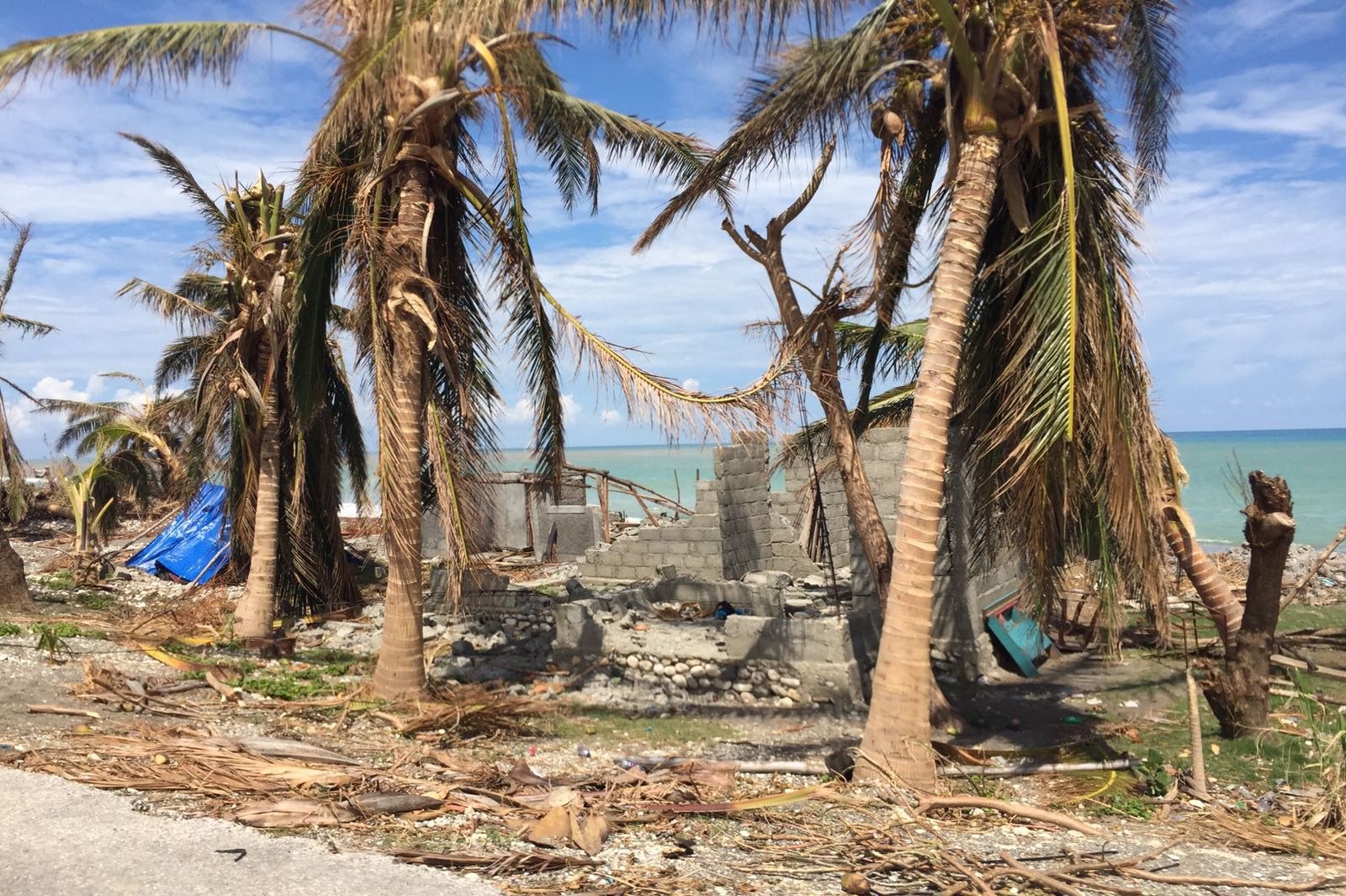
UPDATE: Wednesday, 2 p.m.–Heifer Haiti continues to provide emergency assistance to the more than 6,500 project families who live in the southern region severely affected by Hurricane Matthew.
The aid has come in the form of ready-to-eat food kits, the distribution of 1,000 sanitary kits, 3,500 hot meals for people in shelters, and the treatment of more than 15,000 livestock, for deworming, electrolytes and vitamins.
Supplies were delivered on Monday to repair the water system in Les Anglais. This will restore safe drinking water for 19,000 people. Work to provide water tanks for six additional communities is in progress.
Additionally, Heifer Haiti is partnering with the United Nations World Food Programme to deliver food to Ile a Vache, Les Anglais and Tiburon. The first delivery of food to the island of Ile a Vache is scheduled for the end of this week and will be facilitated by U.S. military helicopters. The 3,500 people in Ile a Vache will each receive a bag of rice (50 kg), a bag of beans (12.5 kg) and cooking oil.
Significant damage – including extreme flooding, loss of agriculture and loss of livestock – is reported in the Heifer communities of Les Cayes, Port Salut, Saint Louis du Sud, Saint Jean, Roche à Bateau, Port à Piment, les Anglais and Chardonnière in the south; Pestel, Dame-Marie, Les Irois, and Anse d'Hainault in the Grand-Anse region; and Marigot in the southeast region.
According to Heifer Haiti Country Director Hervil Cherubin, “Loss of crops, livestock, and housing will cause a real disaster in the coming months. People will not have food to eat or the ability to create income as there are no crops to sell. This will create a huge problem in rural Haiti if something is not done to help the agriculture in the next three months."
-----
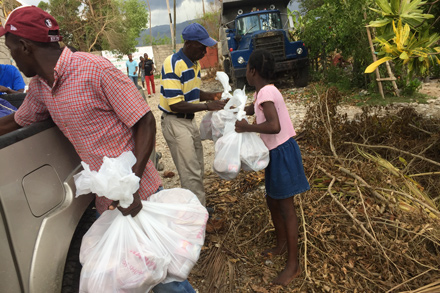
UPDATE: Wednesday, 11 a.m.–Heifer Haiti staff provided support Tuesday to more than 1,500 people in one of the regions hardest hit by Hurricane Matthew, acknowledging the level of need is staggering.
Communities in the westernmost tip of Haiti's southern peninsula have proven difficult to reach in the aftermath of the storm. Heifer staff members arrived in Les Cayes Monday evening and organized: preparing supply kits for distribution, coordinating with other organizations helping in the region, and equipping themselves with chainsaws to help clear the way.
Teams were dispatched from Les Cayes with supplies for several communities in the region. With the help of the mayor in Maniche, 200 kits were distributed. More than 600 went to villages in the Grand-Anse region, 150 kits were distributed in Saint Jean du Sud and around 200 were distributed in Favette.
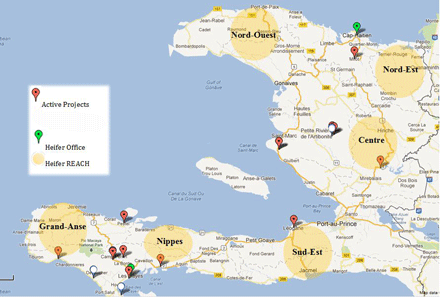
Additionally, more than 500 meals were distributed in shelters. Heifer staff planned to leave extra kits in one community, but it wasn’t possible. Heifer Haiti Country Director Hervil Cherubin explained there was nowhere to safely store the kits, "because there were no houses left with roofs."
“That was when I understood the magnitude of the situation,” he said.
Cherubin reported that Heifer teams were able to reach people “who have been waiting for help for a long time.” He expressed deep concern for the environmental impact this disaster could have on the country. Most of Haiti is severely deforested; the region hit by Hurricane Matthew was one of the few areas of the country holding on to its natural resources.
Today after visiting a few communities and talking with some people, I came to the conclusion that we were facing not only an economic and social disaster, but a severe environmental one as well. This part of the country is definitely in trouble and will need a long, long time to recover. Hervil Cherubin, Heifer Haiti Country Director
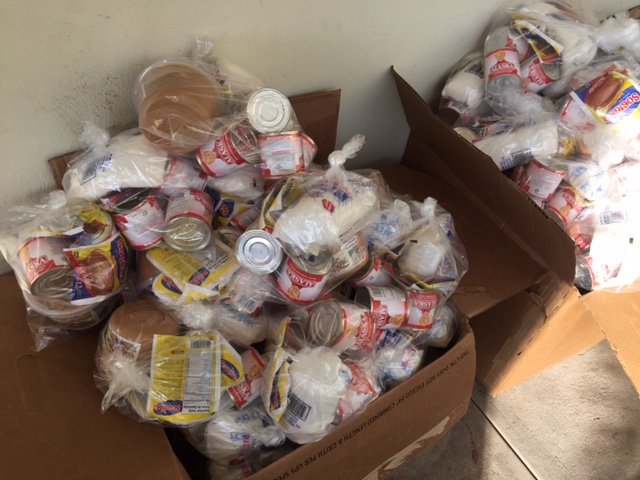
-----
UPDATE: Tuesday, 10 a.m. — Heifer Haiti staff made it to Les Cayes late last night and managed to procure chainsaws to help the teams working to clear the roads to Favette.

"We managed to reach one community of Miragoane (Nippes) and distributed 250 ready to eat kits. We have with us somewhere around 1300 with us that will be distributed in the grand-Anse area and Favette," Cherubin said.
Heifer Haiti is working to get food kits to the southern areas of the country that were hardest hit by Hurricane Matthew.
"We’re working with different suppliers to help us with food kits that have milk, bread, peanut butter, chocolate powder, cassava and other ready-to-eat food stuffs," said Heifer Haiti Country Director Hervil Cherubin.
Cherubin said procurement has become a challenge because prices have gone "through the roof due to shortages."
The team learned over the weekend that two project participant families lost a loved one in the storm. Our thoughts and prayers are with the families who have suffered a loss of a loved one, with our colleagues, and with all in Haiti who are working to assist these communities.
---
UPDATE: Monday, 10 a.m. — Heifer Haiti is working with different suppliers to get food kits to the southern areas of the country that were hardest hit by Hurricane Matthew.
"We’re trying to get supplies to the south so that we can feed about 1,500 people today," said Heifer Haiti Country Director Hervil Cherubin. "We’re working with different suppliers to help us with food kits that have milk, bread, peanut butter, chocolate powder, cassava and other ready-to-eat food stuffs."
Cherubin said procurement has become a challenge because prices have gone "through the roof due to shortages."
Heifer Haiti is also working with a restaurant to provide 500 meals a day to distribute in Les Cayes, Cherubin said. They are also planning to buy chainsaws so they can help the teams working to clear the roads to Favette.
The team learned over the weekend that two project participant families lost a loved one in the storm. Our thoughts and prayers are with the families who have suffered a loss of a loved one, with our colleagues, and with all in Haiti who are working to assist these communities.
----
UPDATE: Friday, 5 p.m. — Heifer Haiti has deployed assessment teams to affected communities in Haiti to provide immediate assistance to our project families in the wake of Hurricane Matthew. The category 4 storm made landfall Tuesday with heavy winds and torrential rain.
In the next three to five months, we might have a food crisis. Hervil Cherubin, Heifer Haiti Country Director
According to Heifer Haiti Country Director Hervil Cherubin, “Based on the data we’re collecting from the field, we’re almost sure that in the next three to five months, we might have a food crisis. The hurricane caused a huge loss. We’re talking about millions of dollars of losses in terms of crops and animals."
More than 6,500 Heifer project families were affected, primarily in the southern region of Haiti. These farmers' agricultural losses so far include:
While our damage report only covers Heifer projects, the data reflects the plight of the entire region hardest hit by the storm. Farmers in the area were planning on harvesting rice, corn and beans by December. Many will not have a crop to sell come Christmas. Plantains, an important staple food in Haiti, also took a major hit courtesy of Hurricane Matthew. "The government is saying 4,500 hectares with 1,300 metric tons have been lost. So half the country won't have plantains until the middle of next year," said Cherubin.
Heifer Haiti is acting to provide both emergency provisions and supplies that can help mitigate the long-term fallout of the disaster.
“The strategy now is to act quickly, start clearing the land and provide farmers with seeds. Heifer International will try to get seeds from other parts of the country that weren’t affected by the storm and distribute them to the people in the south,” said Cherubin.
The effects are likely to extend far beyond the immediate emergency. According to Cherubin, “We’re very worried about the country’s future in terms of food security. The loss of agriculture is severe. Most of the crops are gone. Many of the farm fields are like landfills. They’re full of trash, sea water, gravel and other debris. This will make it difficult for people to start producing soon. I believe it will take at least two years for people to get their farmers producing like they used to.”
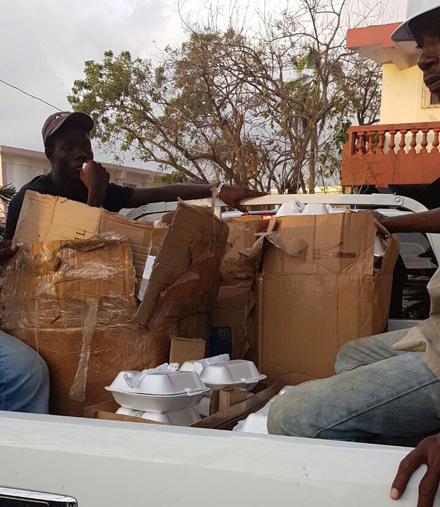
Over the long term, your gifts will help people recover and rebuild.
“It’s going to be rough," said Cherubin. "It’s going to take some time. We have a long way to go to have the people back on their feet. But the people are strong. I think they’ll make it.”
---
UPDATE: Thursday, 2 p.m. — Heifer Haiti will be deploying assessment teams to affected communities to provide immediate assistance to our project families in the wake of Hurricane Matthew. The category 4 storm made landfall Tuesday with heavy winds and torrential rain.
“We’re learning the extent of the problem," said Heifer Haiti Country Director Hervil Cherubin. "It’s not only a human tragedy but also an economic disaster, with a great loss of agriculture, livestock and housing. We still can’t reach some places, but now we have some people on the ground. We are deploying at least 60 veterinary technicians in the regions, with medicine, vaccines and other things to take care of livestock that survived. The Ministry of Agriculture is helping to supply materials.”
More than 6,500 Heifer project families were affected, primarily in the Heifer communities of Les Cayes, Port Salut, Saint Louis du Sud, Saint Jean, Roche à Bateau, Port à Piment, les Anglais and Chardonnière in the south; Pestel, Dame-Marie, Les Irois, and Anse d'Hainault in the Grand-Anse region; and Marigot in the southeast region.
Communities in the northwest region of the country also are affected and will be part of our assessment.
The biggest concerns were the loss of crops, livestock and housing, said Cherubin. "People will not have food to eat or the ability to create income as there are no crops to sell. This will create a huge problem in rural Haiti if something is not done to help the agriculture in the next three months. Livestock is an important asset and an area where Heifer has the unique expertise to provide assistance that can accelerate long-term recovery.”
The immediate goal is to provide food and sanitary supplies, including water treatment tablets, to the more than 6,500 project families affected by the powerful storm, though we will also extend aid to entire communities in need and not just our beneficiaries, Cherubin said. We will also work with the Haitian government to help people in shelters.
The fallout from this disaster is likely to extend far beyond the immediate emergency. According to Cherubin, “We’re very worried about the country’s future in terms of food security. The loss of agriculture is severe. Most of the crops are gone. Many of the farm fields are like landfills. They’re full of trash, sea water, gravel and other debris. This will make it difficult for people to start producing soon. I believe it will take at least two years for people to get their farmers producing like they used to.”
Over the long term, your gifts will help people recover and rebuild.
“It’s going to be rough," said Cherubin. "It’s going to take some time. We have a long way to go to have the people back on their feet. But the people are strong. I think they’ll make it.”
---
UPDATE: Wednesday, 2 p.m. — Heifer Haiti will be deploying assessment teams to affected communities to provide immediate assistance to our project families in the wake of Hurricane Matthew.
Communities in the northwest region of the country also are affected and will be part of our assessment.
The biggest concerns were the loss of crops, livestock and housing, said Heifer Haiti Country Director Hervil Cherubin. "People will not have food to eat or the ability to create income as there are no crops to sell," Cherubin said Wednesday. "This will create a huge problem in rural Haiti if something is not done to help the agriculture in the next three months. Livestock is an important asset and an area where Heifer has the unique expertise to provide assistance that can accelerate long-term recovery.”
The immediate goal is to provide food and sanitary supplies, including water treatment tablets, to the more than 6,500 project families affected by the powerful storm, though we will also extend aid to entire communities in need and not just our beneficiaries, Cherubin said. We will also work with the Haitian government to help people in shelters.
Heifer Haiti will also send more than 60 vet agents/technicians, veterinarians and nurses to care for livestock as soon as the roads open. We will be working with the Ministry of Agriculture to treat injured animals and provide vaccinations and dewormings for animals.
Over the long term, your gifts will help people recover and rebuild.
-----

UPDATE: Tuesday, 11 a.m. — Hurricane Matthew made landfall near Les Anglais in western Haiti as of 7 a.m. this morning, according to the National Hurricane Center. The Category 4 storm slammed the vulnerable nation with 145 MPH sustained winds and torrential rainfall.
Heifer Haiti staff report no loss of life so far, but project participants have already suffered significant material damages including housing, crops and livestock. Heifer Haiti Communications Officer Adassa Romilus reports:
Several of the communities we work with in the southeast are flooded, and their homes have collapsed. Many have lost their roofs. We’re also getting reports of lost livestock – mostly goats – but we don’t have a number yet because we haven’t been able to reach the areas. Heifer is planning to send a team soon, but now it’s too dangerous because of flooding and the threat of mudslides. The communities that we’ve received damage reports from were in Marigot in the southeast and Les Nippes in the south. Adassa Romilus, Heifer Haiti Communications Officer
Romilus added that the storm has overcome some of the cautionary measures taken beforehand. “Many livestock were placed in shelters before the storm, but they died because the shelters couldn’t withstand the force of the hurricane.”
Weak infrastructure, poor sanitation and lack of social safety nets, among other factors, mean that the damage natural disasters such as Hurricane Matthew are capable of wreaking is multiplied many times over when they strike developing nations. Haiti is still reeling from the devastating earthquake of 2010 and the outbreak of cholera that followed soon after.
Most of the people are going to have to start all over again. Whatever they accumulated the last few years has been all washed out. There’s no insurance system in place to help the people. This will really continue the poverty cycle. Hervil Cherubin, Heifer Haiti Country Director
Communication is complicated in the area due to extended loss of electricity, while the threats of floods and mudslides make travel dangerous. We will continue to update here with news about our staff and project participants as soon as we receive information.
Heifer has worked in Haiti since 1999. We currently serve nearly 30,000 families in 36 communities throughout the island.
-----
UPDATE: Monday, 3 p.m. — Heifer Haiti staff were reporting rain and some flooding in southern areas of the island as Hurricane Matthew advanced northward toward the Caribbean nation.
The slow-moving hurricane was expected to hit southwestern Haiti later Monday evening. "The wind is getting stronger and the rain is getting heavier," said Saphinia Sannon, a Heifer project coordinator on Les Cayes, which is in the storm’s path.
"We’ve advised all the farmers to put their livestock in a shelter — a large breeding center in our area,” she added. “We also urged them to prepare to bring plenty of food for the animals," she said.
The National Hurricane Center’s forecast said that after hitting Haiti, the storm would churn toward eastern Cuba late Tuesday before moving to the Bahamas on Wednesday.
Heifer has been in Haiti since 1999. We currently serve nearly 30,000 families in 36 communities throughout the island.
We will continue to update here with news about our staff and project participants as soon as we receive information.
-----
Sunday, 9 a.m. — Heifer International is monitoring Hurricane Matthew as it makes its way through the Caribbean. The category 4 storm is currently threatening Haiti, where we serve nearly 30,000 families in 36 communities.
According to the National Hurricane Center, the hurricane is expected to make landfall in southwestern Haiti and Jamaica on Monday. Though the center is saying Matthew's strength could fluctuate, they said it is likely to "remain a powerful hurricane through Monday night." The NHC also reported maximum sustained wind speeds of 150 mph.
Heifer Haiti is sending updates to staff every few hours, said Heifer Haiti Communications Officer Adassa Romilus. Romilus said Haiti is under a hurricane warning and is expecting two to three days of non-stop rain at the least.
We will continue to update here with news about our staff and project participants as soon as we receive information.
Heifer has been in Haiti since 1999. The focus of our work shifted after the 2010 earthquake when much of the country's infrastructure was destroyed, forcing it to import more than half the food its people need to survive. Our Rural Entrepreneurs for Agricultural Cooperation (REACH) Project is working to increase household income and strengthen livestock by opening animal breeding centers to produce high-quality cattle, goats, swine and poultry.
We're also training Community Animal Health Workers to care for those animals and make sure their populations continue to grow and improve, and helping set up microenterprises around cheese, milk and other products to improve family diets and income. In many communities we are also rehabilitating ecosystems suffering the effects of climate change by focusing on water systems and tree planting.
